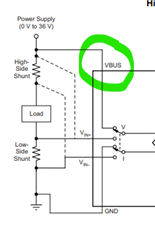I would like to monitor the current using INA226. There is a block diagram shown in the first page of the datasheet. There is HighSide Shunt and LowSide Shunt. Are these two physical resistors I need to connect in the schematic ?
I guess there has to be are two resistors, one is called HighSide Shunt and the other is called LowSide Shunt. Please confirm.
How do I connect two resistors provided there are only two pins IN+ and IN-.
IN+ (Pin 10) Connect to supply side of shunt resistor.
IN- (Pin 9) Connect to load side of shunt resistor.




